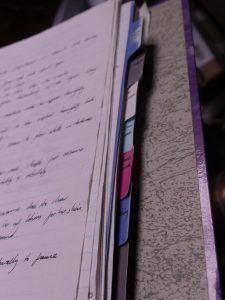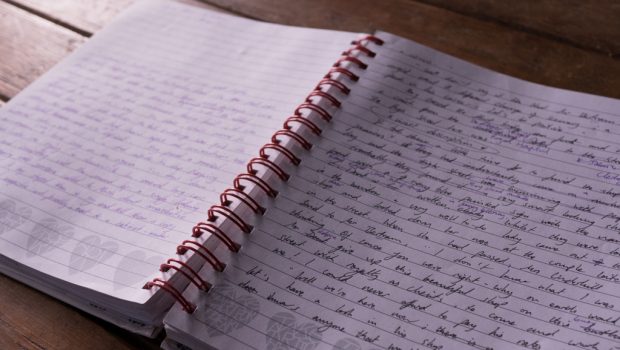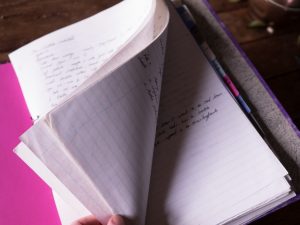In January, a lot people who feel they have a novel in them make it their resolution to get it written; so I thought now would be a good time to write this blog post at it might be helpful. I am currently writing my fourth book (only one published (so far!)) and I think I’ve finally worked out the best way to go about organising my work. This is what suits me the most, so will probably not be helpful to anyone who’s all modern and does everything on the computer, or even on your phone. I’m a long-hand kind-of gal and so notebooks have always featured rather heavily in my writing planning. However this time is slightly different….
In the past I’ve had the notebook for the actual writing of the novel. This hasn’t changed – I write the first draft on one side of the page. Then I go through and do my first edit using a different coloured ink and use the other side of the page for additions and changes. (As seen in the picture above.) Then I type it up, making small corrections and edits as I go. I print it out and then, using a coloured ink I go through and do what I always think will be the final edit. Then I type up those changes and read it through on the screen, hoping that it really is the final edit. I print it out again and do a last read-through. At that point I hope that any changes will only mean re-printing those specific pages. Though a few agents and publishing companies are finally getting with the times and are accepting submissions via e-mail.
 So whilst I have the notebook for writing the story, I have another notebook for the notes – the plot planning, the characterisations and things like that. Sometimes I’ll have another notebook for research as well. This is the bit that I’ve changed because it is always very difficult to find the notes you need to refer to at any given point. Hours can be wasted looking for the description of Mr Beckett’s evil sister or how the giant grass cats’ ancestors hunted for food. Some authors have a card system, but you can’t fit much on a card. So I’m filing instead. I’m writing on lined A4 paper that I’ve kept since the days of being given a hundred sheets per term at school (yes I really am that much of a hoarder – I knew I’d use it one day) and using tabs so I can easily find what I’m looking for. These are the tabs I currently have: Main characters; secondary characters; creatures; the circus; circus research; canals research; setting; Victorian research; Sequel/prequel & spin-off ideas (these always come to me when I’m procrastinating) and finally, plot. I will probably use another set of tabs within the plot section for each chapter; and I might get another set of tabs for each main character – I haven’t decided if I need to yet.
So whilst I have the notebook for writing the story, I have another notebook for the notes – the plot planning, the characterisations and things like that. Sometimes I’ll have another notebook for research as well. This is the bit that I’ve changed because it is always very difficult to find the notes you need to refer to at any given point. Hours can be wasted looking for the description of Mr Beckett’s evil sister or how the giant grass cats’ ancestors hunted for food. Some authors have a card system, but you can’t fit much on a card. So I’m filing instead. I’m writing on lined A4 paper that I’ve kept since the days of being given a hundred sheets per term at school (yes I really am that much of a hoarder – I knew I’d use it one day) and using tabs so I can easily find what I’m looking for. These are the tabs I currently have: Main characters; secondary characters; creatures; the circus; circus research; canals research; setting; Victorian research; Sequel/prequel & spin-off ideas (these always come to me when I’m procrastinating) and finally, plot. I will probably use another set of tabs within the plot section for each chapter; and I might get another set of tabs for each main character – I haven’t decided if I need to yet.
The down side to the A4 filing system is that it is not quite as portable as I’d like. I wrote the first three books mainly sitting outside ballet or kickboxing classes waiting for the kids, and whilst two A5 notebooks could fit in my shoulder bag, an A4 file wouldn’t. Now that I’m mainly writing on my settee, I don’t need to consider these things! If you have a big enough bag though; I still think an A4 file is more portable than boxes of cards.
An advantage of having a file instead of a notebook is that you can move your notes around to put them in chronological order – particularly useful for the plot section. I rarely think in order, so my plot notes are usually all over the place, but now I can make sense of them. Also, as any piece of paper can be hole-punched, if I’m out and about and write an idea on anything to hand (even the classic serviette scenario!), I can just add it when I get home.
I hope this snippet of advice has been useful if you’re in the process of writing. I wish I’d started this way before! I’d be really interested to hear in the comments what your writing system is and if you have any tips to share.




